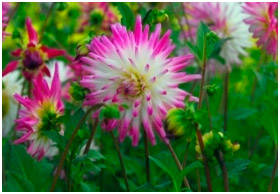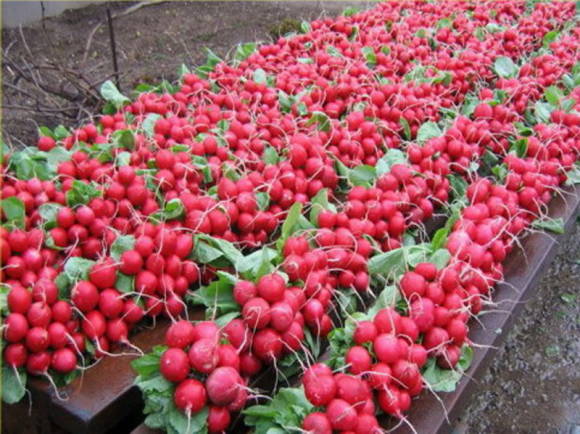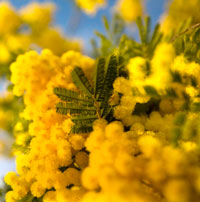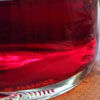Especially valuable are those types of cotoneaster, which are frost-hardy and drought-resistant. Many species thrive in urban conditions and are dust-resistant, are not very demanding on soil fertility and moisture. However, for most species, a calcareous soil is more desirable. They grow well in both light and shade. Only the whole-edged cotoneaster, multi-flowered and pink bloom more luxuriantly and bear fruit in sufficient light. To insure against frost in snowless winters, it is advisable to shelter these more thermophilic cotoneaster for the winter with spruce branches or fallen leaves.
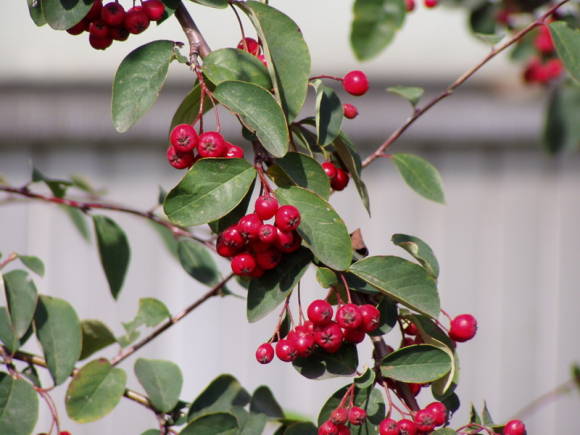 |
These shrubs are simply irreplaceable when arranging hedges, decorating a rock garden and creating decorative groups. They form well, retain their shape for a long time and easily tolerate transplanting at any time of the season.
Planting cotoneaster
All cotoneaster easily tolerates planting. Shrubs with an open root system are planted in a permanent place in the spring - during the period after the soil thaws and before the buds begin to bloom, or in the fall - from massive leaf fall to the first frost. For them, spring planting is most optimal, and autumn planting is also suitable for brilliant and black cotoneaster.
 |
In preparation for planting a cotoneaster hedge, the rope is pulled tightly along the line of the future row of the green fence. Only if this condition is met, the landing turns out to be beautiful and even. For a hedge, dig a trench 50-70 cm deep and up to 50 cm wide, for medium and small species - 35x35 cm.After planting, the soil around each plant must be tamped tightly so that voids do not form in the root zone leading to drying out and death of the shrub.
It is difficult to imagine today a high retaining wall, arranged on a slope, so much so that there is no horizontal cotoneaster. However, in our conditions, it is advisable to limit its use to plantings of 1-5 plants, which are not difficult to cover. The characteristic habit and the way of growth of the shoots of Dammer's cotoneaster make this shrub indispensable for alpine slides and terraces. Ground cover cotoneaster are good in rock gardens, as they are able to braid flat stones with branches and perfectly cover the soil around the trunk circles, decorate the edges of mixborders, provided there is good lighting.
Plant feeding
Useful for cotoneaster, and especially for ornamental varieties, feeding with slurry diluted 5-6 times, or bird droppings diluted 10 times. Fertilizers are applied to the soil not only before planting plants, but also as top dressing during intensive plant growth. Organic fertilizers support the growth of bacteria and increase soil fertility. Summer dressings are very effective, especially for adult shrubs, before and after flowering. During the growing season, feeding is carried out several times, but by August they stop so that the shoots stop growth and have time to woody by winter.
Pruning bushes
Geometrically correct hedges made of winter-hardy cotoneaster species are particularly sophisticated. However, to obtain an even neat hedge and to carry out shaped trimming for a geometric figure, trellis scissors and a tightly stretched rope are needed, but a template in the form of a wooden frame is better. Such a frame or frame can be independently made from bars, for example, in the form of a trapezoid, in which the upper part will be 10-15 cm narrower than the lower one. The choice of the cross-sectional shape of the hedge should correspond to its height and purpose, taking into account a small reserve for the growth of shoots.Immediately before cutting, between two frames installed across the plantings, a rope is pulled, which will adjust the cutting surface with trellis scissors.If the amount of work on pruning is large, then their implementation will greatly facilitate a garden tool - a brush cutter. For young plantings, the annual cutting height should be increased by 5-7 cm to achieve the required hedge size. You should not be especially zealous in removing or cutting the lower tier of branches. It is advisable to leave it 10-15 cm wider than the upper one, which grows more actively and causes partial shading of the lower shoots.
 |
To preserve the decorative effect of less cold-resistant cotoneaster multiflorous, brush-colored and pink, and partly for ground cover species, frozen, dried, broken and damaged shoots are periodically removed, i.e. carry out sanitary pruning. It can be carried out at any time of the season.
Many types of shrubs require rejuvenating pruning, which is associated with the growth and resumption of shoots. The timing of its implementation depends on the durability of the branches, and is determined not only by the biology of the species, but also often by the conditions for growing the shrub. The best time to do this is in spring, before bud break.
In the black and pink cotoneaster, the lower tier at the base of the bush is bare from 4-5 years old, since stem growth poorly develops from this part. With the help of timely pruning, it is possible to artificially induce bud awakening and branching in this area. First, the central axis of the shrub is shortened, then the crown is gradually thinned out, thereby stimulating the renewal of shoots from the trunk and its base. Rejuvenation begins at the age of 15-18, as soon as the skeletal branches begin to dry out and the growth of shoots is weakened.
Cotoneaster pests
In general, cotoneaster is resistant to pests and diseases. Only occasionally a green apple aphid settles on young shoots and the lower surface of the leaves, while the leaves wrinkle, the shoots bend and can dry out. Apple white crumb moth mines the leaf, which leads to the appearance of thin narrow passages on the leaves of the cotoneaster. Damage to some species of cotoneaster, leading to drying of leaves and branches, is caused by scabbard, cotoneaster mite and plum sawfly.
Reproduction methods
 |
Cotoneaster is propagated by seeds, which necessarily need stratification, cuttings, layering, and grafting, in the event that they are used as a rootstock for a pear.
Vegetative reproduction is carried out green (summer) and woody cuttings... Only large, well-developed shoots in a mature state are suitable for green cuttings. If the shoot is soft or too lignified and does not bend well, then it is unsuitable for green cuttings. Cuttings are cut into pieces 10-15 cm long with two internodes. To accelerate root formation, cuttings are placed in a solution of a growth stimulator (heteroauxin), which is prepared from 1 tablet of the substance and 1 liter of water, or sprinkled with powdered Kornevin. Planted in greenhouses under glass in well-washed coarse sand, covered with a layer of 3-5 cmon the main substrate from a sod mixture or humus soil with sand. The soil is well watered before planting. Cuttings are planted to a depth of 5 cm, at an angle of 45 °. The boxes are placed in hotbeds and greenhouses. The rooting rate of cuttings is very different: from 30 to 95%. Rooted cuttings are gradually accustomed to fresh air. By the fall, they have a well-developed root system. Plants can be planted in open ground, but in the first winter they need to be covered with a leaf or spruce branches.
Also, cotoneaster is propagated by lignified (winter) cuttings. For this, shoots are harvested in late autumn or early winter, stored in sand in basements. Only in the spring do they start cutting cuttings 10-20 cm long with three or five buds, which are subsequently rooted in the same way as green ones.
At seed reproduction select benign mature seeds from mature cotoneaster fruits. They are washed from the pulp and soaked in water.In this case, up to 60% of defective seeds usually emerge, which are removed, leaving only viable ones.
The cotoneaster does not have a very high germination of seeds, because the seeds are in a state of deep dormancy, that is, they germinate for a very long time; some shoots appear only in the next spring.
 |
To accelerate germination and increase the germination of seeds of decorative cotoneaster, the method of stratification is used. The seeds are mixed with clean sand and peat, moistened and placed in pots or boxes with a layer of 30-40 cm. There they are kept there until spring at temperatures close to 0 ° C. The seeds of most types of cotoneaster require stratification within 1-2 months, cotoneaster shining and pink - 6-8 months, and multifloral cotoneaster - 10-12 months. For the seeds of prostrate cotoneaster and Dammer, warm-cold stratification is applied: up to 3 months at a temperature of + 20 + 25 ° C, then the first species is 4 months, and the second - 9 months at a temperature of + 4 + 7 ° C. When treating cotoneaster seeds with sulfuric acid for 5-20 minutes. the periods of stratification are shortened by almost a month. The germination rate of cotoneaster seeds is from 5 to 20%.
The seed boxes are filled with light fertile soil, consisting of equal parts of humus, peat and river sand. A good result is obtained by soaking the seeds in water before sowing. When sowing, small seeds are buried 0.5-0.7 cm, that is, they are located almost superficially. The top layer of the substrate is covered with a 1 cm layer of sand. During the germination period, the boxes are regularly watered using a watering can with a fine mesh, and make sure that the seeds are always sprinkled with soil substrate. Watering is carried out carefully, so that a strong stream does not wash out the seeds located superficially. If this happens, then the seeds must be deepened again into the soil. Delicate seedlings are protected by shields from direct sunlight and cold air. Seedlings with developed leaves gently dive into open ground by the end of the season or next spring.
Photo by the author




